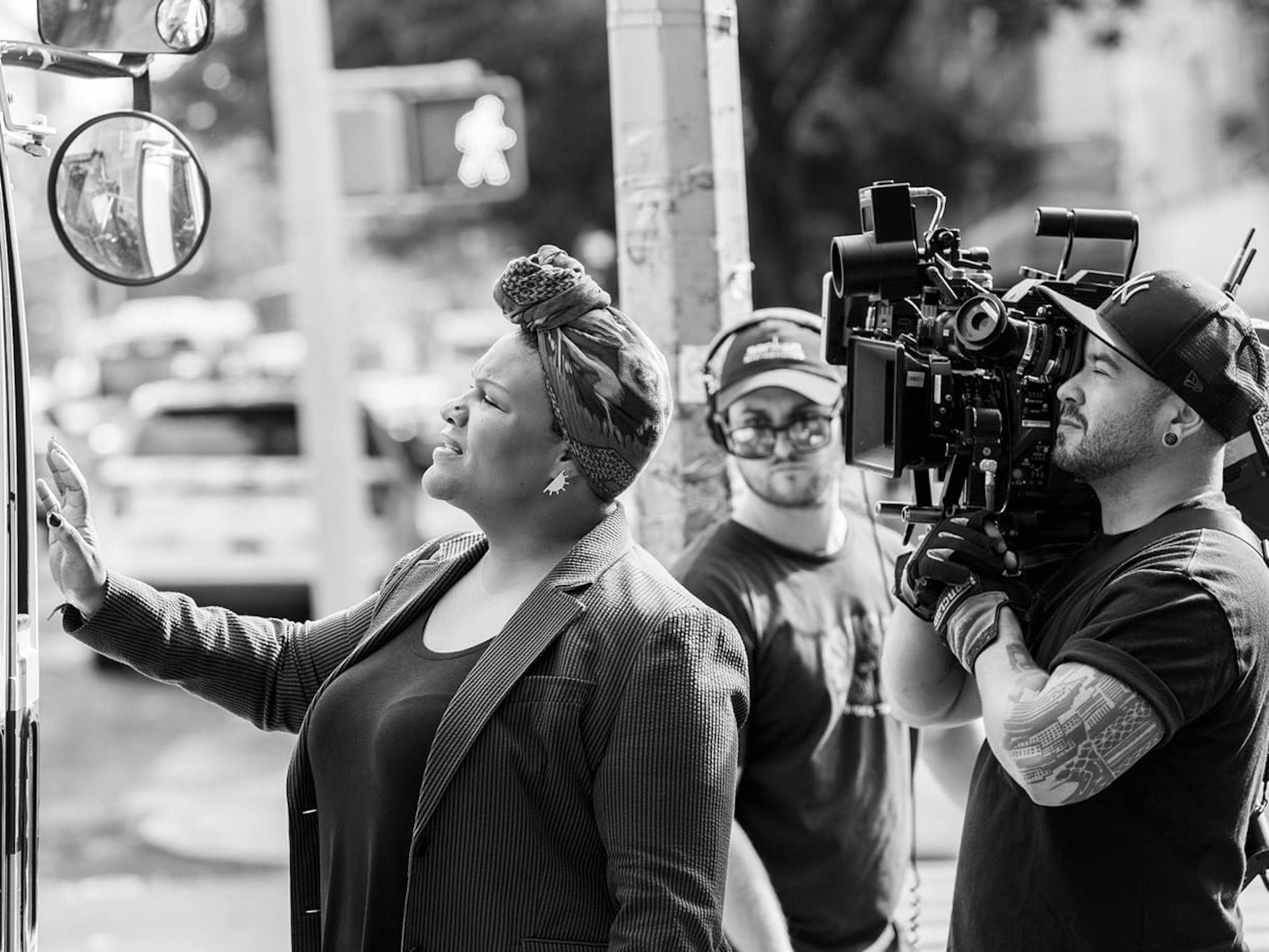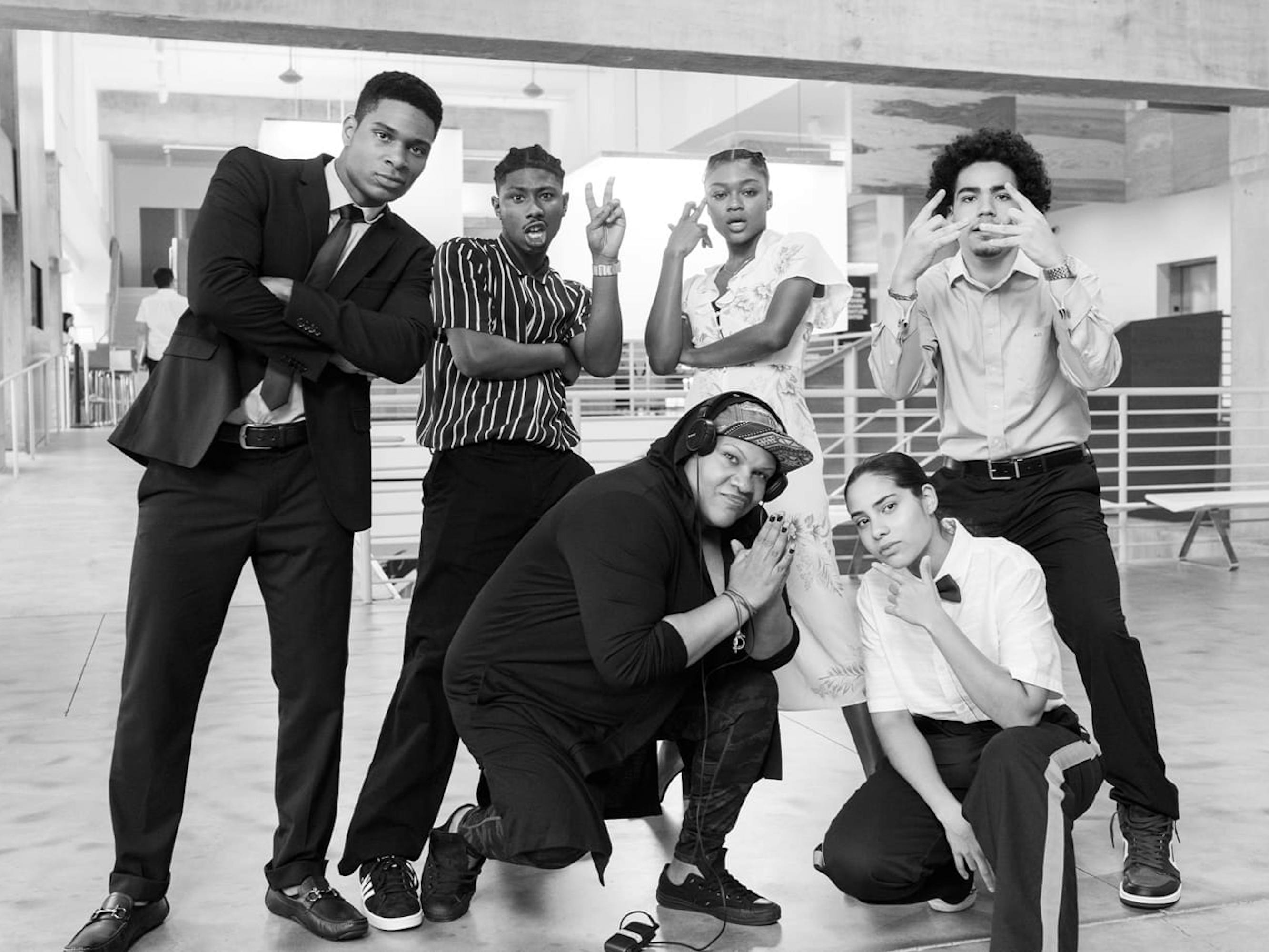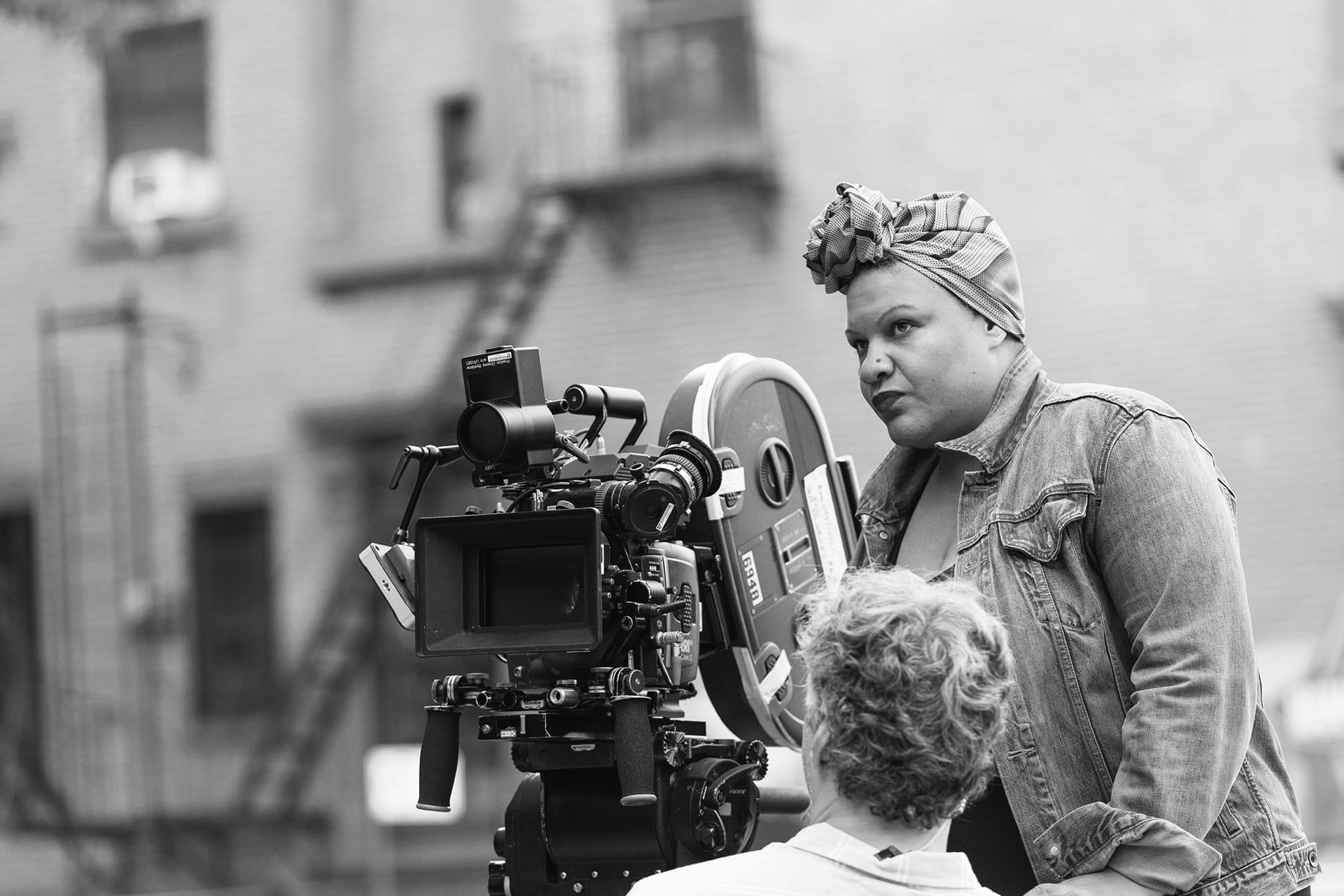Writer-director Radha Blank ruminates on creative frustration and rejuvenation in her debut feature, The Forty-Year-Old Version.
Fair warning: This interview with Radha Blank isn’t business — it’s personal. Right now, like at this very moment, Radha is being introduced to the world as the writer, director, and star of the remarkable new Netflix film The Forty-Year-Old Version. But I remember Radha in the 1990s, smashing open mics at Brooklyn Moon in N.Y.C., rocking a fitted N.Y. Yankees cap and big hoop earrings. I remember her jumping into cyphers and catching wreck (read: she can dance her ass off) at Club Kilimanjaro. I remember sitting in the audience of her play Seed in 2011 and thinking, Damn, homegirl can write. I remember witnessing the rise of her emcee alter ego and one-woman show RadhaMUSprime at Joe’s Pub in 2014 and thinking, Damn, Radha can rhyme. AND she funny AF. Because Radha was (and is) a part of a close-knit artists’ community, I also recall her hustle, the keeping-the-lights-on-while-trying-to-make-your-dreams-come-true shuffle we know so well. Radha worked as a teacher, she wrote for children’s television and for shows such as Empire and She’s Gotta Have It.
So when The Forty-Year-Old Version won the U.S. Dramatic Directing Award at Sundance earlier this year, the community rejoiced! This wasn’t just a win for Radha, it was a win for the people. Here was a film rooted in Radha’s own story, about a woman at 40; a Black artist trying to get her stories told — as a playwright and as a rapper; a daughter grieving the death of her mother. Radha told her story her way, down to shooting the streets of New York on 35mm film in black and white. The result is a whole, liberating mood. There’s even a nod to Prince’s Purple Rain.

Radha Blank on set
Karen Good Marable: First of all, Radha, congratulations! The Forty-Year-Old Version is amazing. Your success feels so much like a win for Brooklyn. A win for us all. Thank you for writing it.
Radha Blank: I really did make it for us — us being Black women, Black women of a certain age, Black women artists of a certain age. I didn’t think I’d be starting a whole new career in my 40s, but I think it speaks to what’s possible if you let go of other people’s ideas of where you should be in your life. If I listened to other people and gave credence to their ideas, I would not be here.
Amen. When you were younger, did you have the boxes to check, i.e., “I need to get this done by 30, I need to get this done by 40”? Were you that girl?
RB: I think I was that girl. And I always say this about aging: It’s never really about the person; it’s about other people’s perceptions that you then take on. I thought by 40, I would be married with a couple of kids, all of my work being published, theaters asking, “Can we do a revival of this play now?” I really thought once I decided to be a playwright, which was probably my mid-20s, I thought, Oh, by 40, I’m going to be set up. I will have a house. And I do have a house, but that came from Cookie and Lucious Lyon. They got me a house.
Come through, Empire.
RB: I feel like we’ve all been conditioned to think that 40 is: You’re an adult, you’re accomplished, you’re established. What me and my character share is there’s still all of these “who am I” moments, questions around identity. Especially when my mother died, I really had to figure out who I was, because so much of my life as a woman, as a person, as a Black American, as an artist, was tied to this woman. When she died, I really had no sense of myself. So I feel like my personal experience propelled me toward telling the story. We just don’t see women of that age saying, What do I do next? Am I happy? Is this enough?
I feel like everything I've learned, I've learned from my mother.
Radha Blank
Your mother — curator, visual artist, cinephile, and arts teacher Carol Blank — figures prominently in the film. She is a goddess and a guide, but she also represents a complicated lesson in what it means to be an artist.
RB: Oh, listen, I feel like everything I’ve learned, I’ve learned from my mother — from my frustration as an artist to being a teaching artist for so long. That’s where I learned how to be a director, honestly. I didn’t go to film school. I did stand-up comedy and all this performance stuff, and my first example was my mother. She knew how to turn a phrase or a joke to get the kids interested, and if they weren’t, she wasn’t going to push it. I learned from her first, and I tried to match her energy.
I don’t know what my mother went through when she turned 40, as an artist. I know she was a mom of two by that time, but I gathered — especially because she was a teaching artist for so many years — that she was hustling, jumping between these different roles, trying to make sense of something for herself. In that way, I feel like the movie and my journey as an artist brought me closer to her. I was like, Oh, this is what you had to go through. And then you had two kids on top of that?
In the film, your character is also a teacher. As much as she tries to model support and positivity, sometimes the frustration seeps through. One line stayed with me: “Don’t think that because you created something, people will appreciate it.”
RB: Yeah, I have been bitter. I was able to transform that into a film; it gave me a story to tell. But I did feel that theater as an institution didn’t pay off, there wasn’t much of a dividend. I had done a play in 2011 called Seed, and everyone was like, “Girl, this is your breakout! This is your moment! This play is going on Broadway!” None of that shit happened. Theater was not responding in the same way. I was quietly devastated by it, and I think the movie is my exploration of the why. How come things didn’t happen for me? Here’s someone who has been trying for 20-something years and my biggest accomplishment was 10 years ago when I was 30. That’s why I invented the 30 Under 30 award for my character: The idea that accomplishments are amplified by one’s proximity to youth. There’s no 50 Under 50 award. Or 60 Under 60. Being young and doing something as an artist seems more of a cause for celebration. You know what I mean?
There’s also this theme of displacement that runs through the film. In addition to your protagonist feeling out of place in the classroom and in the theater community, she’s also setting a play, Harlem Ave, that deals with gentrification.
RB: So, my parents were gentrifiers in their own way in the late 60s and 70s, when they moved to the south side of Williamsburg, Brooklyn. They didn’t displace people, because what they and their artist and jazz musician comrades would do is take over dilapidated spaces that were considered unlivable — broken-down lofts and factories and storefronts — and create community. There was an investment in engaging the community that came before you, whereas now I think gentrification really is just about an opportunity for the person moving in — “Oh, look at this dope, cheap brownstone that I can get” — with no regard for what came before.

Radha Blank with her fellow cast members
Right.
RB: The same thing happens with these artistic institutions: They find a dilapidated space, they revive it and put a million dollars into it. Then when it comes to programming, the people on the stage don’t look like the people outside of the gate. They’re thinking of their silver-haired patrons, because those people can afford a $100 ticket, and that is who I feel most of the theaters cater to. So when diversity shows up on the stage, it’s a version of diversity that protects the audience from feeling bad about racism or sexism. They can still remain in a comfortable place, so they can come back next week or next month and see something for the $300 membership.
Art and culture are happening in these spaces that we’re not always focusing the camera on.
Radha Blank
But then you brilliantly juxtapose said institutions with the battle rap in the Bronx.
RB: I wanted to show these different hubs of art in New York. This film is about capturing an authentic New York experience, and so we shot that battle rap scene at a warehouse space at the tip-top of the Bronx. Art and culture are happening in these spaces that we’re not always focusing the camera on and that don’t have the multimillion-dollar renovation fund of a downtown theater. But this is theater. This is art.
Is that battle based on an actual show?
RB: Yes. Well, we recreated that. Babs Bunny, who people may recognize from Making the Band, created this brand called Queen of the Ring. If you go on YouTube, you’ll see their battle raps. I would watch them because I just needed to see women slaying shit and not being proper or polite. I just wanted to put it into a cinematic world.
Your pen is equally hard-hitting, Radha. Rhymes like “Poverty Porn” and “This Some Bullshit” do so much in revealing character, advancing the narrative.
RB: Thank you. I mean, I feel like if we’re stopping to listen to a song, it should still be about advancing the narrative. We’re still moving forward, riding on this person’s frustration, but into the next scene, next act, or what have you. I think it comes from being a playwright, making sure that everything is earned and not just thrown in there for novelty or because it’s colorful and interesting. I feel like RadhaMUSprime is probably an explosion of her consciousness, the things that she’d been suppressing.But yeah, I’m an emcee. I rhyme. The beautiful thing about the film is I didn’t have to become a professional rapper. I don’t feel like the movie is 8 Mile. I say the movie is 2 Mile, because she’s not trying to go that far. She’s not trying to be a hip-hop star. For her, hip-hop is a meditation and it shows up in many ways, from the trap beat floating outside her window, to her freestyling in the mirror, or with the dudes in the basement cypher at Arlene’s Grocery.
In some ways, the moral and artistic struggles of The Forty-Year-Old Version remind me of Hollywood Shuffle, Robert Townsend’s 1987 classic.
RB: I appreciate that you bring up Hollywood Shuffle, because I know that because I’m Black and I’m shooting in black and white, people always make the comparison to She’s Gotta Have It. But I feel like my film calls back to Hollywood Shuffle, about a Black artist confronting the white gatekeepers on who gets to tell a Black story and how.
Exactly. And like Townsend, you wrote, directed, and starred in your own first feature film. How was that experience, and do you think you would do it again?
RB: I wouldn’t say I regret being in my film, but I think that there’s probably more of a fascination with my film because I’m in it. And I have too much respect for actors to call myself one. I don’t come from training. I don’t sit in these auditions day after day. I don’t have to endure seven callbacks for a role. I just think that when an audience is familiar with a face, it might make it easier for them to go down the line with this person. So while I don’t plan on being in another one of my films, I do plan on mining my family legacy for storytelling, and on telling stories where music is a driving force.I really want to be an auteur. I’m hoping that my stories get quieter. Very quiet, but very potent. A slow burn, but such a beautiful payoff. I want to make work like that.
Amen.
